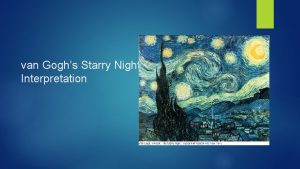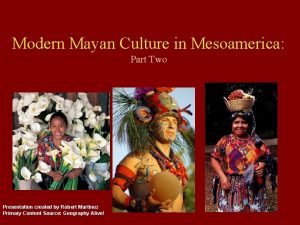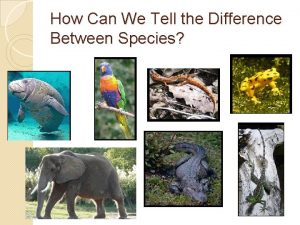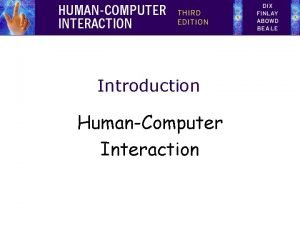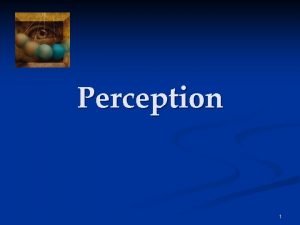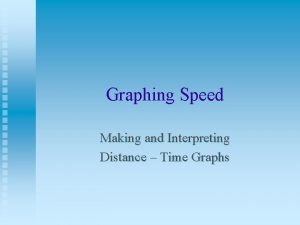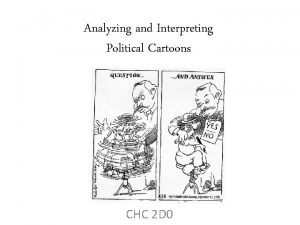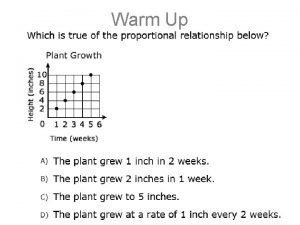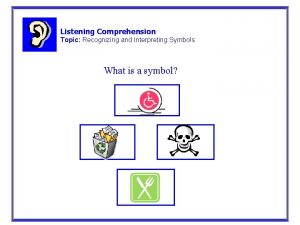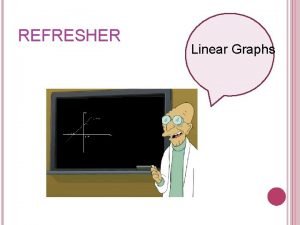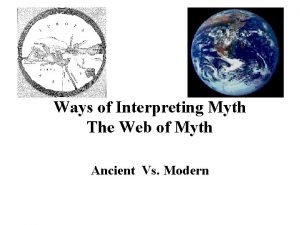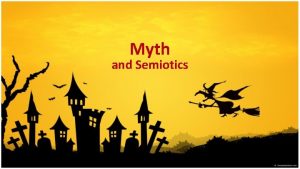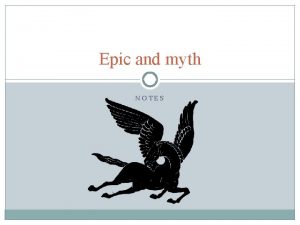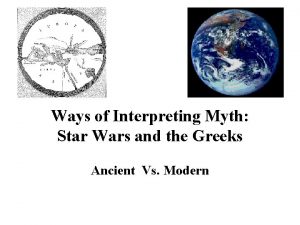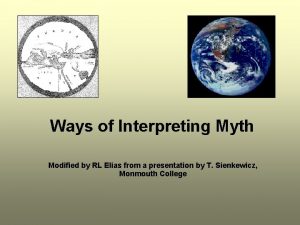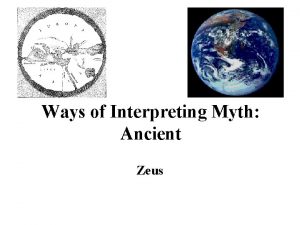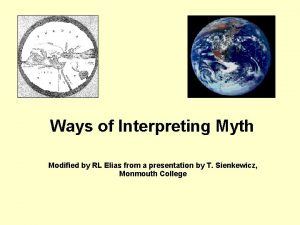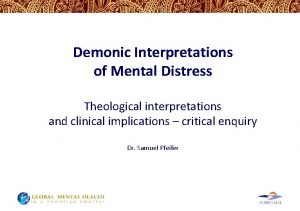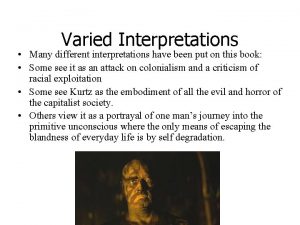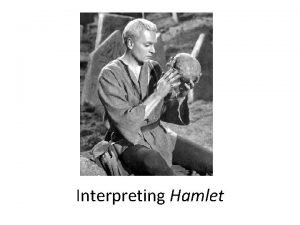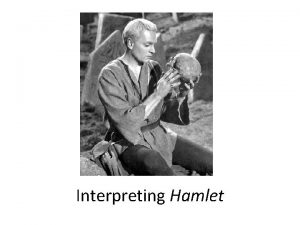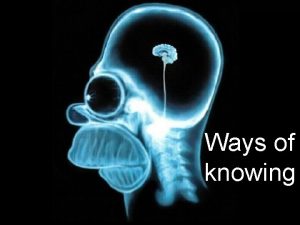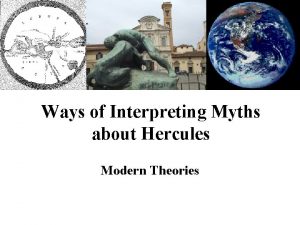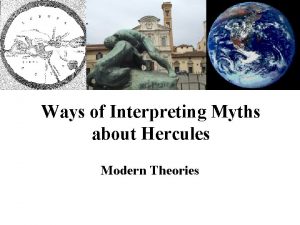Ways of Interpreting Myth Modern Modern Interpretations of

































- Slides: 33

Ways of Interpreting Myth: Modern

Modern Interpretations of Myth Two modern meanings of “mythology”: • a system or set of myths • the methodological analysis of myths A monolithic theory of myth vs. the multifunctionalism of myth The autonomy of myth See: Some Theories of Myth Externalist Theories: Myths as Products of the Environment Internalist Theories: Myths as Products of the Mind

Externalist Theories: Myths as Products of the Environment Myths as Aetiology Comparative Mythology Nature Myths as Rituals Charter Myths

Myths as Aetiology myth as explanation of the origin of things myth as primitive science myth as explanation of customs What aetiologies are in the myth of Zeus?

Myths as Aetiology Zeus myth explaining Greek custom regarding sacrifice: Athenian red-figure vase, 430 -420 BC. Louvre http: //www. bbc. co. uk/history/ancient/greeks/greek_olympics_gallery _02. shtml http: //quatr. us/greeks/religion/sacrifice. htm

Myths as Aetiology Zeus myth explaining Greek custom regarding sacrifice: Hesiod’s Theogony (ll. 507 -543) Now Iapetus took to wife the neat-ankled mad Clymene, daughter of Ocean, and went up with her into one bed. And she bare him a stout-hearted son, Atlas: also she bare very glorious Menoetius and clever Prometheus, full of various wiles, and scatter-brained Epimetheus who from the first was a mischief to men who eat bread; for it was he who first took of Zeus the woman, the maiden whom he had formed. But Menoetius was outrageous, and far-seeing Zeus struck him with a lurid thunderbolt and sent him down to Erebus because of his mad presumption and exceeding pride. And Atlas through hard constraint upholds the wide heaven with unwearying head and arms, standing at the borders of the earth before the clear-voiced Hesperides; for this lot wise Zeus assigned to him. And ready- witted Prometheus he bound with inextricable bonds, cruel chains, and drove a shaft through his middle, and set on him a long- winged eagle, which used to eat his immortal liver; but by night the liver grew as much again everyway as the long-winged bird devoured in the whole day. That bird Heracles, the valiant son of shapely-ankled Alcmene, slew; and delivered the son of Iapetus from the cruel plague, and released him from his affliction -- not without the will of Olympian Zeus who reigns on high, that the glory of Heracles the Theban-born might be yet greater than it was before over the plenteous earth. This, then, he regarded, and honoured his famous son; though he was angry, he ceased from the wrath which he had before because Prometheus matched himself in with the almighty son of Cronos. For when the gods and mortal men had a dispute at Mecone, even then Prometheus was forward to cut up a great ox and set portions before them, trying to befool the mind of Zeus. Before the rest he set flesh and inner parts thick with fat upon the hide, covering them with an ox paunch; but for Zeus he put the white bones dressed up with cunning art and covered with shining fat. Then the father of men and of gods said to him:

Myths as Aetiology Zeus myth explaining Greek custom regarding sacrifice: Hesiod’s Theogony Cont. (ll. 543 -544) `Son of Iapetus, most glorious of all lords, good sir, how unfairly you have divided the portions!' (ll. 545 -547) So said Zeus whose wisdom is everlasting, rebuking him. But wily Prometheus answered him, smiling softly and not forgetting his cunning trick: (ll. 548 -558) `Zeus, most glorious and greatest of the eternal gods, take which ever of these portions your heart within you bids. ' So he said, thinking trickery. But Zeus, whose wisdom is everlasting, saw and failed not to perceive the trick, and in his heart he thought mischief against mortal men which also was to be fulfilled. With both hands he took up the white fat and was angry at heart, and wrath came to his spirit when he saw the white ox-bones craftily tricked out: and because of this the tribes of men upon earth burn white bones to the deathless gods upon fragrant altars. But Zeus who drives the clouds was greatly vexed and said to him: (ll. 559 -560) `Son of Iapetus, clever above all! So, sir, you have not yet forgotten your cunning arts!' (ll. 561 -584) So spake Zeus in anger, whose wisdom is everlasting; and from that time he was always mindful of the trick, and would not give the power of unwearying fire to the Melian (21) race of mortal men who live on the earth.

F. Max Müller Nature Myths Founder of the social scientific study of religion Comparative approach: Study of Vedic peoples of ancient India applied to myths of other cultures (Greece and Rome) Max Müller 1823 -1900) For Müller, the culture of the Vedic peoples represented a form of nature worship, an idea clearly influenced by Romanticism Aeschylus, Fragment 70 (Heliades [Daughters of Helios]) Zeus is the fiery upper air, Zeus is the earth, Zeus is the heaven; Zeus is all things, and whatever transcends them.

Zeus as the Sky • Dyaus pitr Sanskrit – Dyaus = “he who shines” – pitr = father • Zeus pater Greek • Jupiter Latin • Tiu Vater Teutonic (German) Indo-European

Myths as Ritual Sir James Frazer’ The Golden Bough (1890 -1915) Comparative mythology myths as by products of ritual enactments stories to explain religious ceremonies

Turner’s “Golden Bough” Joseph M. W. Turner (1775 -1851) The Golden Bough 1834 Tate Gallery, London http: //www. tate. org. uk/servlet/View. Work? cgroupid=99996&workid=14718

Myths as Ritual Sir James Frazer’ The Golden Bough (1890 -1915) Comparative mythology myths as by products of ritual enactments stories to explain religious ceremonies The Golden Bough On-Line: http: //www. bartleby. com/196/

Myths as Ritual Zeus myth explaining Greek custom regarding sacrifice: Athenian red-figure vase, 430 -420 BC. Louvre http: //www. bbc. co. uk/history/ancient/greeks/greek_olympics_gallery _02. shtml http: //quatr. us/greeks/religion/sacrifice. htm

Charter Myths belief-systems set up to authorize and validate current social customs and institutions. Bronsilaw Malinowski (1884 -1942) Selected Bibliography: http: //www. vanderbilt. edu/An. S/Anthro/ Anth 206/malinowski. htm Does the myth of Zeus validate social customs and institutions?

Myths as Ritual Zeus myth explaining Greek custom regarding sacrifice: Athenian red-figure vase, 430 -420 BC. Louvre http: //www. bbc. co. uk/history/ancient/greeks/greek_olympics_gallery _02. shtml http: //quatr. us/greeks/religion/sacrifice. htm

Structuralism Claude Lévi-Strauss (1908 -) Jean-Paul Vernant Pierre Vidal-Naquet

Claude Lévi-Strauss (1908 -) • myth reflect the mind's binary organization • diachronic vs. synchronic reading of myth • humans tend to see world as reflection of their own physical and cerebral structure ( two hands, eyes, legs, etc. ) • Left/right, raw, /cooked, pleasure/pain • Myth deals with the perception and reconciliation of these opposites • mediation of contradictions How does Zeus mediate contradictions? For more on Levi-Strauss see http: //www. mnsu. edu/emuseum/information/biography/klmno/levi -strauss_claude. html

Mediating Contradictions in Aeschylus’ Zeus “Hymn to Zeus” (Aeschylus. Agamemnon 160 -182) Zeus: whatever he may be, if this name pleases him in invocation, thus I call upon him. I have pondered everything yet I cannot find a way, only Zeus, to cast this dead weight of ignorance finally from out my brain. He who in time long ago was great, throbbing with gigantic strength, shall be as if he never were, unspoken. He who followed him has found his master, and is gone. Cry aloud without fear the victory of Zeus, you will not have failed the truth: Zeus, who guided men to think, who has laid it down that wisdom comes alone through suffering. Still there drips in sleep against the heart grief of memory; against our pleasure we are temperate From the gods who sit in grandeur grace comes somehow violent. “Wisdom comes alone through suffering. : Zeus is the mediation between these two contradictions. Zeus also mediates between grace and violence,

Narratology Vlaimir Propp (1895 -1970) Propp argued that all fairy tales were constructed of certain plot elements, which he called functions, and that these elements consistently occurred in a uniform sequence. Based on a study of one hundred folk tales, Propp devised a list of thirty-one generic functions, proposing that they encompassed all of the plot components from which fairy tales were constructed. What narrative functions are in the myth of Zeus?

The Hero Pattern This pattern is based upon The Hero: A study in Tradition, Myth and Dreams by Lord Raglan Incidents which occur with regularity in hero-myths of all cultures: 1. Hero's mother is a royal virgin; 2. His father is a king, and 3. Often a near relative of his mother, but 4. The circumstances of his conception are unusual, and 5. He is also reputed to be the son of a god. 6. At birth an attempt is made, usually by his father or his maternal grand father to kill him, but 7. he is spirited away, and 8. Reared by foster -parents in a far country. 9. We are told nothing of his childhood, but 10. On reaching manhood he returns or goes to his future Kingdom. 11. After a victory over the king and/or a giant, dragon, or wild beast, 12. He marries a princess, often the daughter of his predecessor and 13. And becomes king. 14. For a time he reigns uneventfully and Click on the name to see the pattern applied to the life of : 15. Prescribes laws, but Mithradates VI of Pontus (22) / Krishna (21) / Moses (20) 16. Later he loses favor with the gods and/or his subjects, and / Romulus (19) / King Arthur (19) / Perseus (18) / Jesus (18) / Watu 17. Is driven from the throne and city, after which Gunung of Java (18) / Heracles (17) Mohammad (17) / Beowulf (15) 18. He meets with a mysterious death, / Buddha (15) / Czar Nicholas II (14) / Zeus (14) / Nyikang, a cult 19. Often at the top of a hill, hero of the Shiluk tribe of the Upper Nile (14) / Samson (13) 20. His children, if any do not succeed him. / Sunjata, the Lion-King of Ancient Mali (11) / Achilles (10) 21. His body is not buried, but nevertheless / Odysseus (8) / Harry Potter (8) 22. He has one or more holy sepulchres.

Johann Jakob Bachofen (1815 – 1887)

Feminist Approaches to Myth Marija Gimbutas (1921 -1994) Marija Gimbutas was an archaeologist with a scholarly background in folklore and linguistics, making her uniquely qualified to synthesize information from science and myth into a controversial theory of a Goddess-based culture in prehistoric Europe. Joseph Campbell said that, if her work had been available to him, he would have held very different views about the archetypes of the female Divine in world mythology. Primacy of Matriarchy What about Zeus?

Matriarchy and Patriarchy Hesiod’s Theogony (ll. 886 -900) Now Zeus, king of the gods, made Metis his wife first, and she was wisest among gods and mortal men. But when she was about to bring forth the goddess bright-eyed Athene, Zeus craftily deceived her with cunning words and put her in his own belly, as Earth and starry Heaven advised. For they advised him so, to the end that no other should hold royal sway over the eternal gods in place of Zeus; for very wise children were destined to be born of her, first the maiden bright-eyed Tritogeneia, equal to her father in strength and in wise understanding; but afterwards she was to bear a son of overbearing spirit, king of gods and men. But Zeus put her into his own belly first, that the goddess might devise for him both good and evil.

Myths as Products of the Mind Individual Mind Sigmund Freud (1856 -1939) id / ego / superego dream world of the individual Does Zeus appeal to our individual dream world?

Myths as Products of the Mind Collective Mind Carl Jung (1875 -1961) dream world of society collective unconscious archetypes: recurring myths characters, situations and events archetype as primal form or pattern from which all other versions are derived Does Zeus appeal to our collective unconscious?

Students of Jung Ernst Cassirer (1874 -1975) Mircea Eliade (1907 -1986) Victor Turner (1920 -1983) Joseph Campbell (1904 -1987)

Mircea Eliade (1907 -1986) Eliade's analysis of religion assumes the existence of "the sacred" as the object of worship of religious humanity. Myths reflect a creative era, a sacred time, a vanished epoch of unique holiness. Is Zeus living in a vanished epoch? More on Eliade: http: //www. angelfire. com/electronic/bodhidharma/mircea. html

Joseph Campbell 1904 -1987 Hero's rite of passage journey of maturation Growth into true selfhood (Jung's individuation) More on Campbell: http: //www. jcf. org/about_jc. php

Myth and Dream Myths as Products of the MIND The Monomyth (James Joyce’s Finnegan’s Wake)

Rite of Passage separation—initiation--return (See Hero Pg. 30)

Tragedy and Comedy in the Monomyth – “The universal tragedy of man” – “The happy ending of the fairy tale, the myth, and the divine comedy of the soul, is to be read , not as a contradiction, but as a transcendence of the universal tragedy of man. ” (pg. 28) – It is the business of mythology proper, and of the fairy tale, to reveal the specific dangers and techniques of the dark interior way from tragedy to comedy. (pg. 29) – Is Zeus part of the Monomyth?

The World Navel The world navel is ubiquitous. And since it is the source of all existence, it yields the world’s plentitude of both good and evil. ” (Campbell, Pg. 44) The omphalos The effect of the successful adventure of the hero is the unlocking and release again of the flow of life into the body of the world. (Campbell, pg. 40) Delphi, the navel of the Greek world

Zeus and the Omphalos The famous Omphalos (“navel” of the world) was an undecorated holy stone kept in the innermost of the temple in Delphi, covered with a knotted woolen net. It was flanked by two golden eagles. This stone indicated the exact centre of the world, as proven by a scientific experiment by the god Zeus. He had two eagles, one from the eastern end of the earth and one from the west, flying towards each other. The point where they met (at Delphi) had to be the exact centre. The stone which is exhibited in the museum (decorated with the same net) probably stood in front of the temple, being a copy of the original. http: //www. pausanias-footsteps. nl/english/delphieng. html
 Ways of interpreting myth
Ways of interpreting myth Gods ways are not our ways
Gods ways are not our ways What are historical interpretations
What are historical interpretations Far 117 interpretations
Far 117 interpretations Far 117 interpretations
Far 117 interpretations Today nanotechnology produced computer transistors
Today nanotechnology produced computer transistors Starry night interpretation
Starry night interpretation In what ways have the highland maya adapted to modern life?
In what ways have the highland maya adapted to modern life? Cladogram analysis worksheet answer key
Cladogram analysis worksheet answer key Types of interpreting
Types of interpreting What relationship
What relationship Cengage medical terminology
Cengage medical terminology Interpreting the signal in hci
Interpreting the signal in hci Vertex form.
Vertex form. Selecting organizing and interpreting information
Selecting organizing and interpreting information Creating and interpreting distance time graph
Creating and interpreting distance time graph Interpreting political cartoons 2 answer key
Interpreting political cartoons 2 answer key Northern ireland interpreting service
Northern ireland interpreting service Http://trialcourtweb/
Http://trialcourtweb/ Analyzing and interpreting data in research
Analyzing and interpreting data in research Interpreting circle graphs
Interpreting circle graphs Interpreting graphs of proportional relationships
Interpreting graphs of proportional relationships Interpreting the quotient
Interpreting the quotient Analyzing and interpreting data in research
Analyzing and interpreting data in research Fsa reporting categories
Fsa reporting categories Identify the 7 principles in interpreting parables
Identify the 7 principles in interpreting parables Mmpi 2 rf interpretation
Mmpi 2 rf interpretation Gish model of interpreting
Gish model of interpreting Interpreting symbols
Interpreting symbols K5 learning interpreting figurative language
K5 learning interpreting figurative language Interpreting graphics
Interpreting graphics Interpreting the bill of rights
Interpreting the bill of rights Interpreting linear graphs
Interpreting linear graphs Brigance cutoff scores
Brigance cutoff scores






